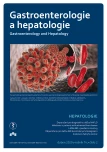Endoscopic drainage of infected pancreatic necrosis with complicated course – case report
Authors:
Bawadekji Hexspoor D. 1; Tichý T. 1; Urban O. 1; Falt P. 1,2
Authors‘ workplace:
II. interní klinika – gastroenterologie a geriatrie LF UP a FN Olomouc
1; Katedra interních oborů, LF UK v Hradci Králové
2
Published in:
Gastroent Hepatol 2020; 74(2): 135-138
Category:
doi:
https://doi.org/10.14735/amgh2020135
Overview
This report describes a 55-year-old patient, who was transferred from a regional hospital for acute severe necrotizing pancreatitis complicated by the development of large, infected, walled-off pancreatic necrosis. Because of severe septic shock with high perioperative risk and multiorgan failure requiring artificial lung ventilation, the patient underwent endoscopic transgastric drainage of the walled-off pancreatic necrosis using a metallic lumen apposition stent. Efficient drainage and repeated endoscopic necrectomy resulted in overall gradual improvements in patient condition. Due to the complete regression of fluid collection after 5 weeks the metallic stent was extracted. The patient was fully realimented and rehabilitated after 2 months of hospitalization and was transferred to ambulatory care.
Keywords:
stent – acute pancreatits – drainage – endoskopy – pancreatic necrosis
Sources
1. Thoeni RF. The revised Atlanta classification of acute pancreatitis: its importance for the radiologist and its effect on treatment. Radiology 2012; 262(3): 751–764. doi: 10.1148/ radiol.11110947.
2. Manrai M, Kochhar R, Gupta V et al. Outcome of acute pancreatic and peripancreatic collections occurring in patients with acute pancreatitis. Ann Surg 2018; 267(2): 357–363. doi: 10.1097/ SLA.0000000000002065.
3. Kliment M, Urban O, Fojtík P et al. Endoskopická drenáž pankreatických tekutinových kolekcií – 6-ročná skúsenosť v terciárním gastroenterologickom centre v období rokov 2006–2012. Gastroent Hepatol 2017; 71(3): 199–207. doi: 10.14735/ amgh2017199.
4. Rasch S, Phillip V, Reichel S et al. Open Surgical versus minimal invasive necrosectomy of the pancreas – a retrospective multicenter analysis of the German Pancreatitis Study Group. PLoS One 2016; 11(9): e0163651. doi: 10.1371/ journal.pone.0163651.
5. Bakker OJ, van Santvoort HC, van Brunschot S et al. Endoscopic transgastric vs surgical necrosectomy for infected necrotizing pancreatitis: a randomized trial. JAMA 2012; 307(10): 1053–1061. doi: 10.1001/ jama.2012.276.
6. Akshintala VS, Saxena P, Zaheer A et al. A comparative evaluation of outcomes of endoscopic versus percutaneous drainage for symptomatic pancreatic pseudocysts. Gastrointest Endosc 2014; 79(6): 921–928. doi: 10.1016/ j.gie.2013.10.032.
7. Tenner S, Baillie J, DeWitt J et al. American College of Gastroenterology guideline: management of acute pancreatitis. Am J Gastroenterol 2013; 108(9): 1400–1416. doi: 10.1038/ ajg.2013.218.
8. Al-Omran M, Albalawi ZH, Tashkandi MF et al. Enteral versus parenteral nutrition for acute pancreatitis. Cochrane Database Syst Rev 2010; (1): CD002837. doi: 10.1002/ 14651858.CD002837.pub2.
Labels
Paediatric gastroenterology Gastroenterology and hepatology SurgeryArticle was published in
Gastroenterology and Hepatology

2020 Issue 2
Most read in this issue
- Covid-19 and the liver
- Endoscopic drainage of infected pancreatic necrosis with complicated course – case report
- Guideline of the Czech Hepatology Society of the ČLS JEP for diagnosis and treatment of non-alcoholic fatty liver disease
- Doporučení pro léčbu idiopatických střevních zánětů v době pandemie covid-19
